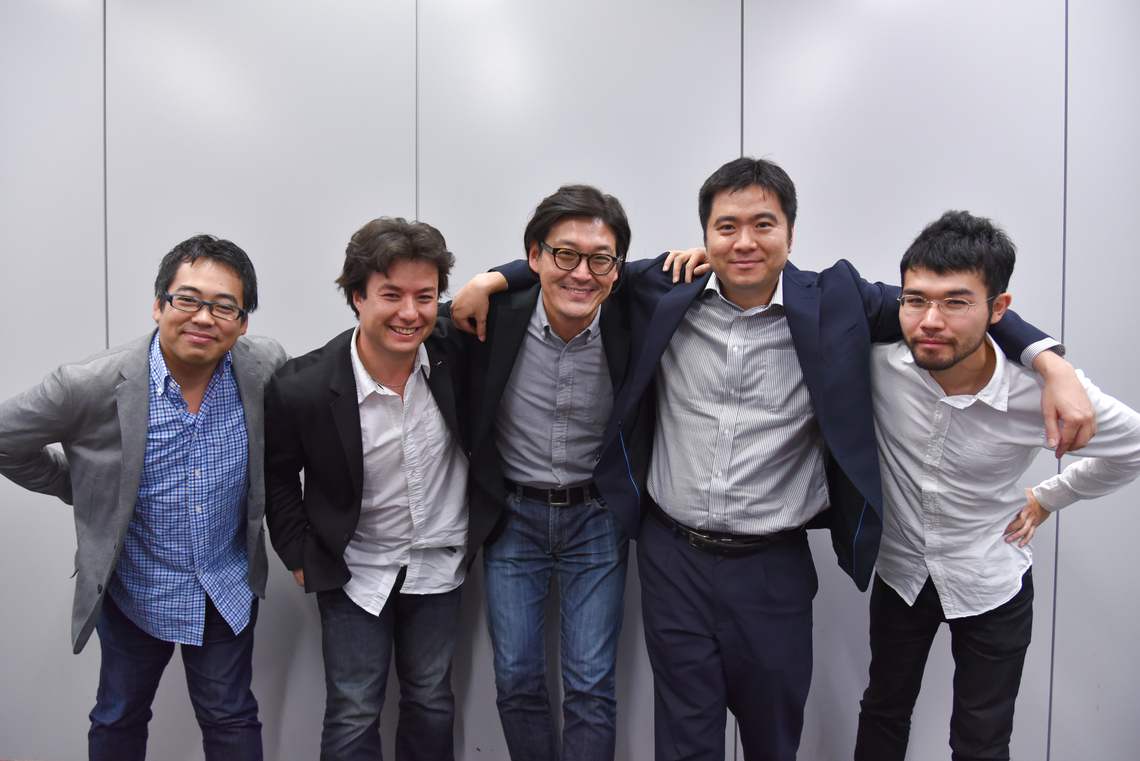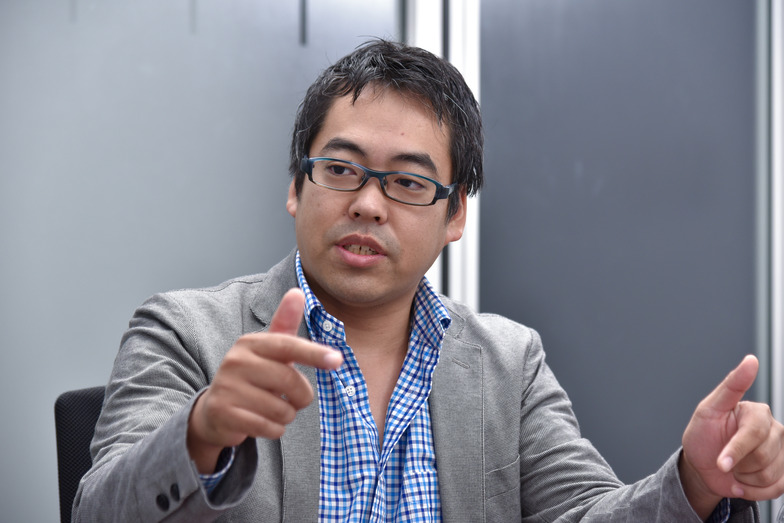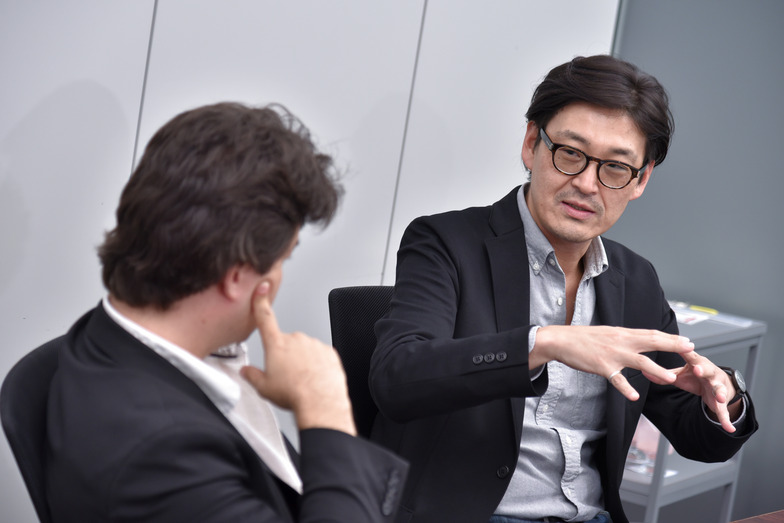In August, four companies—Dentsu Inc., Dentsu International Information Services (ISID), btrax, Inc., and Infobahn—launched "DSquad," a task force supporting corporate innovation creation. They will provide support across the entire innovation process: from building internal innovation frameworks within client companies, to researching domestic and international market trends, designing innovation platforms and reviewing design specifications, evaluating prototypes, and even matching with partner companies. Taking advantage of the visit to Japan by Brandon Hill of San Francisco-based btrax, we spoke with representatives from the four companies about the growing focus on service design and user experience (UX), and their vision for DSquad.

From left: Naoki Mori (Dentsu Inc.), Brandon Hill (Btrax), Yuichi Inoto (Infobahn), Yasuyuki Hayashi (ISID), Yohei Noguchi (Dentsu Inc. CDC, not present for roundtable)
In the IoT Era, Elevating UX to a Global Level
――Please tell us about the background behind establishing DSquad.
Mori: At Dentsu Inc., our team primarily helps companies grow their businesses by enhancing user experience (UX) through digital design and user interfaces (UI). However, we've seen a sharp increase in requests for advice on how to establish digital service domains and touchpoints. Amid the major trend of IoT (Internet of Things) integrating digital with all products and services, manufacturers, airlines, financial institutions, and a wide range of industries are beginning to recognize that refining the user experience is essential for sustainable growth going forward.
In my daily work, I've identified three key challenges. First, the desire to elevate UI and design to global standards. Second, marketing technology is evolving at an incredible pace. Web design now directly links to ad delivery and CRM, making collaboration with system integrators (SIers) essential for UI design. Finally, building UX cannot be achieved through superficial design or digital experiences alone. To tackle these three challenges, I reached out to individuals possessing the best expertise and technology, leading to the establishment of DSquad.
――How did you feel when approached, members of Beetracks, ISID, and Infobahn?
Brandon: Beatracks is based in San Francisco. While fundamentally a design firm, we provide Japanese companies with the latest insights in UI, UX, and product development methodologies through research and workshops, also assisting with new business development. At DSquad, we also aim to serve as a bridge to cutting-edge Silicon Valley expertise.
Hayashi: ISID is an SIer, but the wave of marketing technology is reaching us here too. We strongly felt the need to move beyond the traditional model of building and delivering large, complex systems over long periods. Instead, we must flexibly expand IT solutions in response to changing circumstances—such as whether consumers actually took action—and connect this to sales and loyalty building. DSquad's participation came at just the right time for this shift. I'm excited to take on challenges that will shift our mindset as an SIer by working alongside UX and media experts.
Ito: At Infobahn, we strongly desire to be a unique and flat organization. While our fundamental stance is to prioritize direct contracts that allow us to engage directly with clients whenever possible, we actively seek collaboration with companies possessing expertise and insights we lack. This time, we saw an opportunity to take on an exciting initiative that broadly views design as the business itself and considers a management vision for ten years ahead, which is why we decided to participate. Beatrix is based in the most technologically and conceptually advanced area of the West Coast, so we also expect that working together will further expand our knowledge. At DSquad, we plan to primarily handle the part of the project focused on uncovering what users currently need to drive innovation through UX, translating research and discovery into UX design.
Mori: Bitracks is on the West Coast, but Infobahn has a network in Europe, right?
Itō: That's right. We have business partnerships with design firms based in Sweden and the Netherlands. Since Europe is particularly advanced in UX and service design, we're strengthening our collaboration with European design innovation firms and service design companies.
Mori: DSquad is quite a challenging area even for Dentsu Inc. But the global trend is definitely moving in this direction. To provide solutions to client companies, we feel we must somehow get ahead of the curve. We want to find effective points of contact and provide solutions for companies that want to do innovative things but are constrained by traditional rules and can't fully move forward.
In Europe and the US, it has already become central to public services and corporate strategy.
――Beatrax handles a lot of work for major Japanese corporations on the West Coast. How do you perceive the differences between Japan and the U.S. in terms of connecting your company's core competencies to the digital domain?
Brandon: There are definitely far more companies in the U.S. that understand the importance of UI and UX. Not only tech-focused startups, but even large corporations have their top executives and management positioning UX as fundamental to their business operations. It's not just a matter of having an interest; if you lack a certain level of awareness, you risk being dismissed. There are also various seminars and workshops available after work hours, and everyone actively participates.
In contrast, in Japan, while some younger employees grasp the importance of UX, I feel many people above a certain level of seniority just don't get it. I think Japan needs to change this for future global competitiveness.
Ito: In Europe, initiatives to cultivate organizational value through UX design and service design are already thriving across broad domains like public services, healthcare, and finance.
They recognize UX strategy as the most core part of a company, so they acquire top external design firms or assemble experts to establish independent design teams. That's the biggest difference from Japan. Furthermore, management consulting firms and innovation firms are also aggressively buying up design firms. Attend any design conference, and you'll almost always hear talk of this somewhere.
Brandon: When they don't have an in-house team, they effectively leverage external design firms. For example, when I visited Airbnb with Mr. Mori, I was quite shocked to learn they outsourced their entire UX app.
Particularly in startups prioritizing speed, partnering with external design firms as collaborators has become established practice. With the IoT trend, more companies are handling hardware alongside software, and many are outsourcing not just hardware design but the entire UX design—the interface between software and hardware—externally. I think they're doing this decisively to keep pace with the speed of the times.
Mori: Japanese companies do tend to cling to in-house development, don't they? Even at Dentsu Inc., while we handle the communication aspects, clients typically complete the core product or service development internally. Even when outsourcing design, they often finalize specifications first and then only outsource superficial elements, keeping most control within their own organization.
Brandon: From a Western perspective, that's actually quite unusual. Take Italy's automotive industry, for example. They have carrozzerie like Pininfarina, which designed the Ferrari. In Japan, UI work might be handled by engineers or graphic designers, but in the West, you tell a design agency the end goal and let them devise the best strategy to achieve it.
The premise is that you hire them because they're better than you; if they can't do something beyond your own capabilities, there's no need to pay them. So, once you've commissioned them, you show the final KPI-like goals but avoid interfering unnecessarily.
Mori: In Europe and America, world-renowned creative boutiques often handle UX, right? There's a strong awareness of enhancing value as a platform to capture customers—the service delivery space equals the brand experience space. But here, even for Dentsu Inc. projects, while temporary campaign sites demanding bursts of creativity might have dedicated staff, you won't find Cannes-winning star creators working on, say, a bank's service interface.
Ito: I think it's a matter of how "design" is defined. Design is often perceived as just the visible "aesthetics" – surface colors, shapes, and such – and it ends up being separated from product development. Design is seen merely as part of marketing, and the management perspective isn't really incorporated there. In many Japanese companies, the departments responsible for design and digital still seem weaker compared to management departments or even IT departments handling infrastructure.
But if you separate business and design in your definition, you won't generate new ideas, and you won't reach the potential that might have been achievable in today's fast-paced environment. It's easier to understand if you think about the web. In the mid-90s, the web was handled by IT-related departments. It gradually became just one channel for marketing, and recently it's becoming the core of the entire business.
Recently, as channels and contact points have multiplied, the web alone can't handle everything, making overall UX increasingly important. In Japan, departments overseeing IT or marketing often still handle UX separately, but I believe it will eventually follow a similar evolution to the web.
Brandon: Come to think of it, I've never exchanged business cards with anyone at a major Japanese corporation whose card says "Designer."
Mori: True. In Europe and the US, designers and creative directors hold positions of real significance.
Brandon: I believe the correct interpretation of design is that it's a means of solving problems. That is, solving management problems. It's crucial for designers themselves to recognize this. Incidentally, Battista Pininfarina, the founder of Pininfarina, said something like, "There are two reasons for good design. One is that it is loved by people and used for a long time. The other is that it sells."
Ito: Thomas J. Watson, who built IBM, also said "Good Design, Good Business." Since ancient times, good design has equaled good business.
Mori: The design we're talking about here isn't just superficial. It refers to the combination of visible design and the platform as a system that provides the so-called experience. Understanding this is crucial.
The triangle of business, design, and IT will become increasingly important going forward. Japanese companies are strong in foundational technology, but often lack sufficient cross-functional collaboration, such as investing in connecting that to user experience. Departments also operate in silos. But as mentioned repeatedly earlier, design is management. It will undoubtedly have a major impact on corporate competitiveness going forward. At DSquad, we sincerely hope to assist in raising awareness and driving transformation in this area.
(Continued in Part 2 )















